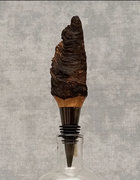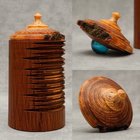Has anybody here ever turned Fat Wood?
-
April 2025 Turning Challenge: Turn an Egg! (click here for details) -
Congratulations to Kelly Shaw winner of the March 2025 Turning Challenge (click here for details) -
Congratulations to Ellen Starr for "Lotus Temple" being selected as Turning of the Week for 21 April, 2025 (click here for details) -
Welcome new registering member. Your username must be your real First and Last name (for example: John Doe). "Screen names" and "handles" are not allowed and your registration will be deleted if you don't use your real name. Also, do not use all caps nor all lower case.
You are using an out of date browser. It may not display this or other websites correctly.
You should upgrade or use an alternative browser.
You should upgrade or use an alternative browser.
Fat Wood?
- Thread starter Tom Albrecht
- Start date
A long time ago I found an old pine tree that had been down awhile that had a core of fat wood. I harvested as much as I could to use as fire starter and had to turn some just because... It was so pungent it burned my eyes and irritated my sinuses. It was fun to throw the shavings into the fire. If you can imagine the "whoosh" sound gasoline makes when it lights, that's the sound the shavings made. There was resin buildup on the gouge but WD-40 removed it no problem. As I recall, it was vary hard, cut beautifully, surface off the tool had a beautiful rich look and the small bowl I made had some translucency. Even with the irritations, if I found some more, I would have to turn a small something....
I have made a few Fatwood things Tom. It does cut beautifully, but you can’t really sand it it well. Maybe wet sanding, but it would be a pain. Very, very fragrant of course. It’s been a while since I’ve turned it, but I have several pieces in the shop waiting for their chance. Here is a bottle stopper I turned, as well as a box (the lid is a Fatwood spin top).




One thing to note about Fatwood is that it's somewhat difficult to finish (because of the resin content). You could likely buff the surface directly and get a nice luster (just guessing). For the spin top above, I first rubbed it down with several coats of alcohol, and then finished with several coats of thin shellac.
Fat wood? No thanks. Shavings stuck to everything, tools, lathe, wall, and me. My shop smelled like terpentine for a week. The bowl l turned about 3 years ago resurfaced just last week, and l decided to look up the other half of log and try it again. It didn't take long for my memory to kick in, and that project was abandoned to the burn pile before l had too big of a mess to clean up. The original bowl seems to have dried; so l plan to try to finish it.
- Joined
- Feb 28, 2021
- Messages
- 1,569
- Likes
- 1,372
- Location
- Roulette, PA
- Website
- www.reallyruralwoodworks.com
Never even heard of Fat Wood until today. Had to go ask Bing.
what is fat wood?
Old pine that is thick with resin and sap. Frequently sold as kindling wood. I have a friend in the south west who found a few small logs he's going to send me. Here's an internet definition:
Fatwood is simply dried wood that is full of resin or pitch. Typically taken from the wood of old pine stumps left for waste after logging, it is made from splitting the stumps of pine trees that contain a high concentration of natural resin. As the stumpwood hardens over time, the resin or sap concentrates to create an all-natural, 100% organic, chemical-free fire starter.
When a pine tree dies, the resin in the roots gets drawn into the stump. The stump becomes saturated with resin and as it rots away, the resin-soaked wood at core of the stump hardens. This is why you can see dark veins t hroughout the fatwood, that is the resin.
The resin itself contains terpene, the main component of turpentine which of course is highly flammable. This is also why fatwood shavings can be lit with just a spark, even when wet. So if you don’t have a lighter with you, don’t worry! Fatwood shavings make excellent tinder for any purpose of fire you may need.
Fatwood is simply dried wood that is full of resin or pitch. Typically taken from the wood of old pine stumps left for waste after logging, it is made from splitting the stumps of pine trees that contain a high concentration of natural resin. As the stumpwood hardens over time, the resin or sap concentrates to create an all-natural, 100% organic, chemical-free fire starter.
When a pine tree dies, the resin in the roots gets drawn into the stump. The stump becomes saturated with resin and as it rots away, the resin-soaked wood at core of the stump hardens. This is why you can see dark veins t hroughout the fatwood, that is the resin.
The resin itself contains terpene, the main component of turpentine which of course is highly flammable. This is also why fatwood shavings can be lit with just a spark, even when wet. So if you don’t have a lighter with you, don’t worry! Fatwood shavings make excellent tinder for any purpose of fire you may need.
WE always called it lighter pine.
Many of us old southern boys call it 'pine knots'. The best way to dull a chain saw other than poking in dirt is to cut a pine knot. But must confess, I never heard the term 'fatwood' until this posting.Old pine that is thick with resin and sap. Frequently sold as kindling wood. I have a friend in the south west who found a few small logs he's going to send me. Here's an internet definition:
Fatwood is simply dried wood that is full of resin or pitch. Typically taken from the wood of old pine stumps left for waste after logging, it is made from splitting the stumps of pine trees that contain a high concentration of natural resin. As the stumpwood hardens over time, the resin or sap concentrates to create an all-natural, 100% organic, chemical-free fire starter.
When a pine tree dies, the resin in the roots gets drawn into the stump. The stump becomes saturated with resin and as it rots away, the resin-soaked wood at core of the stump hardens. This is why you can see dark veins t hroughout the fatwood, that is the resin.
The resin itself contains terpene, the main component of turpentine which of course is highly flammable. This is also why fatwood shavings can be lit with just a spark, even when wet. So if you don’t have a lighter with you, don’t worry! Fatwood shavings make excellent tinder for any purpose of fire you may need.
As a side note, these new fast wood genetically engineered pine trees do not produce fatwood (pine knots).
As a side note, these new fast wood genetically engineered pine trees do not produce fatwood (pine knots).
They also do not produce very interesting looking wood.
They also do not produce very interesting looking wood.
Thanks Tom, I am afraid it sounds like desert for termites, havent seen any where I am and termites we have in abundanceOld pine that is thick with resin and sap. Frequently sold as kindling wood. I have a friend in the south west who found a few small logs he's going to send me. Here's an internet definition:
Fatwood is simply dried wood that is full of resin or pitch. Typically taken from the wood of old pine stumps left for waste after logging, it is made from splitting the stumps of pine trees that contain a high concentration of natural resin. As the stumpwood hardens over time, the resin or sap concentrates to create an all-natural, 100% organic, chemical-free fire starter.
When a pine tree dies, the resin in the roots gets drawn into the stump. The stump becomes saturated with resin and as it rots away, the resin-soaked wood at core of the stump hardens. This is why you can see dark veins t hroughout the fatwood, that is the resin.
The resin itself contains terpene, the main component of turpentine which of course is highly flammable. This is also why fatwood shavings can be lit with just a spark, even when wet. So if you don’t have a lighter with you, don’t worry! Fatwood shavings make excellent tinder for any purpose of fire you may need.
That’s interesting to think about. Pine resin is definitely tasty to termites, but I’ve for sure seen termite infested logs where the fat wood sections (primarily the bases of limbs) remain untouched. Makes you think.Thanks Tom, I am afraid it sounds like desert for termites, havent seen any where I am and termites we have in abundance
Fat wood has a very strong smell. I’d equate it to camphor on steroids (but with a pine/fir smell instead of Vicks lol)
I once stripped the interior walls of an old converted porch that was infested with termites. When we got to the #2 1X6 exterior sheathing it was very obvious that termites avoided the knots and the dark resinous streaks.
